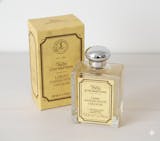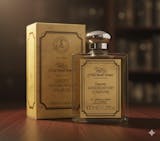Do Native Americans Have Facial Hair?

Photo: ©️ DMBONDARUK via depositphotos.com
Native Americans are known for sporting almost-perfectly clean-shaven faces with their charismatic allure. And we know what you are thinking: do Native Americans have facial hair?
Here at Naked Armor, as America gears up to commemorate the man who “discovered” the New World, we cannot help but wonder how Columbus might have also been responsible for spreading the gospel of shaving.
If so, how much did Columbus and his band of travelers influence the natives’ grooming routine? Or did the Native Americans always have no facial hair?
In this article:
- Why Native Americans Don’t Have Facial Hair
- Beard Growing Tips for Native Americans
- Columbus: The Shaving Prophet
- Did Native Americans Shave Before the New World?
- Straight Razor Shaving
Why Native Americans Don’t Have Facial Hair
It can be hard to have an encounter with a pure Native American with a Viking beard. But, as R.C. Lewis said, “just because you don’t see something doesn’t mean it isn’t there.”
Hence, the answer to the question “Do Native Americans have facial hair?” is yes. So, next time you meet one, do not be too surprised.
Native Americans do not appear to have facial hair because they are not genetically predisposed to growing thick hair everywhere on their bodies. And, no. It is not because of ethnicity, as a matter of fact, Native Americans do have facial hair, but it is very soft and sparse.
Genetics, maybe?
Genetics could be a contributing factor to the lack or sparsity of facial hair in Native Americans. But it's essential to consider the complexity of the issue. The variation in facial hair growth may be influenced by a combination of genetic diversity, hormonal differences, historical interactions with other populations, cultural practices, environmental adaptations, diet, and individual variations.
It's not merely a result of ancestral preferences against facial hair. Over generations, these multifaceted factors, coupled with the fact that there are more than 500 distinct tribes across Native American communities, could have shaped the facial hair patterns observed today. It's important to recognize that within any Native American tribe or ethnic group, there can be significant diversity in facial hair growth due to these factors.
Blame the pictures
 Source: Jonathan Hall in his answer to a query in Quora.
Source: Jonathan Hall in his answer to a query in Quora.
If you have not met any Native Americans yourself, you may have a stereotype that Native Americans do not have facial hair—only because that is what most of the photos online (and movies) want you to believe. However, Native Americans with beards do exist.
But, of course, due to their perception of facial hair, they, of course, would not want to have a beard (no matter how full or sparse it may be) on their formal portraits. Before their “picture taking” sessions, they plucked away all the hair on their faces.
Some argue that the lack of facial hair in Native Americans is because of their ancestry links to East Asians. However, scientists still have to come up with a significant conclusion to this theory due to limited resources and complicated migration patterns.
Beard Growing Tips for Native Americans
 A beard and mustache oil will allow you to take care not just of your facial hair but of the skin underneath as well.
A beard and mustache oil will allow you to take care not just of your facial hair but of the skin underneath as well.
There are a lot of factors to consider when it comes to growing beards, and one of them is your genetics. Today’s Native Americans already have a mixture of different ethnicities in their blood. Some may even have European origins, which makes it much easier for them to grow a beard.
However, if you are a pure Native American, you might need to put on some more effort for your beard-growing journey. There have been claims that a good diet for growing a beard needs to be rich in vitamins and minerals like biotin, iron, and Vitamin B5. These nutrients can trigger your beard growth by helping the growth and reproduction of healthy cells.
The American Academy of Dermatology (AAD) has some excellent tips from dermatologists for growing a beard. For instance, Anthony Rossi, MD, FAAD, a board-certified dermatologist and Mohs surgeon, recommended men to take care of their skin by cleansing and moisturizing the area using beard oil, like our Thor Beard and Mustache Oil, which has all the nutrients your beard and skin needs to thrive.
Columbus: The Shaving Prophet?
 Portrait of Christopher Columbus
Portrait of Christopher Columbus
Photo: ©️ The Everett Collection via canva.com
Shaving was already part of European culture in Columbus' time. In the 15th century, it was customary for the elite to have barber-surgeons who shaved their beards. These professionals would flit between shaving their steel straight razors on the scalps of the nobles to lancing the wounds of the sick and injured.
However, no one is sure whether Columbus wore a beard throughout his years as an explorer. That is because nobody today knows what he looks like. But if we think of him, we picture a tall, vigorous Italian guy with a blonde beard and hair and blue eyes.
No beard, no problem
When Columbus and his bros reached the American coast, you best believe they were relieved to see the natives having no manly facial manes.
Alex Kerner, in his paper Beard and Conquest: the Role of Hair in the Construction of Gendered Spanish Attitudes towards the American Indians in the Sixteenth Century, said that the absence of beards among Native Americans gave the conquistadores a sense of superiority that ultimately fueled their perception of the natives as beings that could legitimately be subdued.
He wrote that:
“The reference to hair is sometimes made in conjunction with or right next to a description of what in the view of the Christians, was the natives’ low moral standards, as if the natives’ different attitude to hair also expressed their lack of virtue, their non-observance of moral codes pertaining to sex, and even worse, as an expression of the male natives’ natural tendency towards homosexuality.”
The general absence of facial hair among Native Americans showed their weakness as a race because he thought it characterized submissiveness and inferiority. His European beard, meanwhile, gave him moral superiority and the license to subdue just about everyone in the New World.
On the other hand, the natives are probably looking at them in disgust as in their culture. These intruders looked barbaric and unclean.
So, no. Columbus was not accountable for influencing the Native Americans to have clean-shaven faces. But he and his ilk sure did modernize the way Native Americans groomed their hairs.
Did Native Americans Shave?
If facial and body hair appalled Native Americans so much, they must have shaved way before Columbus turned up. Considering the amount and type of hair they had, shaving was not necessary.
Shaving as we know it today was not a thing for the Native Americans until the late 1800s. When Columbus came, they introduced the natives to metal pinchers, which later became a status symbol for the elites in the tribe.
They used tweezers made of wood or pinchers made from the shell of a freshwater mussel. The shell was an ideal tweezer because it had a natural spring hinge. It could be held easily in one hand and its sharp lips would cut into the hair at its roots so that it can be pulled off easily.
In instances where the hair on the scalp needed to be shaved off, Native Americans used obsidian flakes. An obsidian is a type of hard, glasslike volcanic rock that is used by Native Americans as knives. These are very sharp and cut with great efficiency. However, when they become dull through constant use, they cannot be resharpened. Instead, the Native Americans recycled them into smaller arrowheads.
Obsidian
However, if shaving were indeed necessary for shaving the head and other larger areas of the body, Native Americans would use an ancient wet shaving tool, the obsidian.
This rugged, glass-like volcanic rock is a staple tool that Native Americans also used as knives. And when they get dull, instead of resharpening, Native Americans give them a second life by turning the obsidian into smaller arrowheads.
You know how people like to talk about taking on a paleo-diet, that Stone Age healthy menu that makes you sprightly and strong? Well, this guy’s on that similar spectrum; only this time, he is, touting the benefits of wet shaving with a Stone Age tool.
Meet Mike Cook, a flintknapper and primitive skills educator. In this video, he shows us how wet shaving uses flakes chipped from a block of obsidian. It is a bit scary, considering there is no handle attached to the obsidian blade.
That is how they did it in the olden days. We bet that Columbus would think twice about using obsidian for shaving, though. Go ahead and watch.
Straight Razor Shaving
Having watched that video, we can honestly say using an obsidian is an acquired taste. Here at Naked Armor, we prefer to shave in comfort and luxury with our collection of straight razor blades made from high-grade Japanese steel.
Without a doubt, Columbus would be amazed by this since it is the same quality steel used by the Samurai centuries ago. But of course, since he was a prig and a product of his century, we guess he would give it a side-eye at first. But with its hardness rating of 61-65 HRC and a blade so sharp it can serve as one’s samurai weapon, he will be thinking twice.
We do not use it for anything other than shaving, though. One of the reasons why the Solomon Straight Razor blade cuts cleanly and smoothly is because we designed it to be a hybrid of a full hollow and a half hollow to make sure that we capture all the best aspects of the razor shaving.
If you are a newbie looking to experience a new level of shaving with a straight razor, we recommend you check us out. If you are a professional, we guarantee our razors will add a luxurious dimension to your shaving experience.
And so, in the spirit of Columbus Day, we encourage you to set foot in a whole new world of luxurious shaving by trying out a Naked Armor straight razor. Click Add To Cart now to order.
More Naked Armor Reads:
Straight Razor & History of Shaving
Straight Razor Basics: How the Modern Straight Razor is Produced
Why Are Razor Blades So Expensive?




























Hi Mari. Thank you so much for your comment! Glad that you found our article useful.
Very interesting article on Native American hair removal. It offered some useful information, wondering what other sources were used? Alex Kerner, Beard and Conquest: the Role of Hair in the Construction of Gendered Spanish Attitudes towards the American Indians in the Sixteenth Century was another very intriguing read. Coming all the way from Israel I most likely would not have come across it while researching pre-contact lifestyles in North America.
Any other resources/articles/references are appreciated. Also want to say, it is awesome that your company is able to provide meals to people in various communities!!
Leave a comment